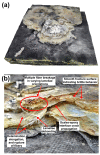Energy Absorption and Ballistic Performance of Epoxy Composite Reinforced with Arapaima Scales
- PMID: 37050228
- PMCID: PMC10096586
- DOI: 10.3390/polym15071614
Energy Absorption and Ballistic Performance of Epoxy Composite Reinforced with Arapaima Scales
Abstract
Arapaima scales possess a hierarchical structure capable of absorbing a considerable amount of energy before fracture. These natural dermal armors present significant potential in the sustainable development of cost-effective composites. This work aimed, for the first time, to analyze the impact resistance and ballistic performance of arapaima scale-reinforced epoxy composites and their potential application in multilayered armor systems (MAS). Composite plates were prepared with 20%, 30%, and 40 vol% of arapaima scales. Composite specimens were subjected to notched Izod impact and residual velocity stand-alone tests and their MAS through backface signature (BFS) tests, with their fracture surfaces studied using SEM. The Izod tests confirmed the effect of scales' volume fraction on the energy absorbed by the composites, showing an increase with volume fraction. Residual velocity tests showed that composites with 30 vol% of scales resulted in the most significant improvement in absorbed energy. All MAS formulations presented BFS depths lower than the trauma limit specified by the NIJ standard. Fractographic analysis showed that the scales' toughening mechanisms improved the composites' energy absorption capacity. The experimental results substantiate the potential use of arapaima scales as a reinforcement agent in polymeric composites, with 30 vol% being the optimal volume fraction for energy-absorbing applications.
Keywords: DGEBA/TETA epoxy; arapaima fish scales; ballistic behavior; energy absorption; green composites.
Conflict of interest statement
The authors declare no conflict of interest.
Figures













References
-
- Zhang Z., Cai S., Li Y., Wang Z., Long Y., Yu T., Shen Y. High performances of plant fiber reinforced composites—A new insight from hierarchical microstructures. Compos. Sci. Technol. 2020;194:108151. doi: 10.1016/j.compscitech.2020.108151. - DOI
-
- Lau K., Hung P., Zhu M., Hui D. Properties of natural fibre composites for structural engineering applications. Compos. Part B Eng. 2018;136:222–233. doi: 10.1016/j.compositesb.2017.10.038. - DOI
-
- Sanjay M., Madhu P., Jawaid M., Senthamaraikannan P., Senthil S., Pradeep S. Characterization and properties of natural fiber polymer composites: A comprehensive review. J. Clean Prod. 2018;172:566–581. doi: 10.1016/j.jclepro.2017.10.101. - DOI
LinkOut - more resources
Full Text Sources

